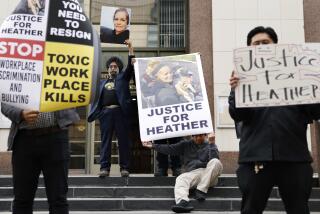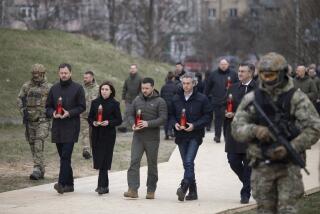Dogged Nuclear Inspectors in Global Spotlight : Iraq: The explosive standoff in Baghdad culminates a six-month exercise in frustration.
WASHINGTON — A dogged band of United Nations nuclear inspectors suddenly drew global attention Tuesday as Iraq and the United States edged closer to the brink of armed confrontation when the U.N. experts uncovered a priceless stash of documents describing the Iraqi nuclear program in unprecedented detail.
David A. Kay, the American leader of the 44-person inspection team that has been detained twice this week by Iraqi authorities, said in a televised interview that the group was on the verge of finding out “the true scope and nature” of the Iraqi nuclear weapons program.
The explosive standoff in Baghdad culminated a six-month exercise in frustration, during which the U.N. inspectors have faced official Iraqi obstruction in ways large and small from the very outset of the inspection program in May.
The inspectors, most of whom have not been identified in an effort to shield them from terrorists, represent several U.N. member states and were recruited for their technical expertise in nuclear, chemical and biological weaponry. For the most part, they are civilian, academic experts, not military intelligence specialists.
They operate out of the Persian Gulf island city-state of Bahrain, flying into a military airfield west of Baghdad and fanning out from there to track Iraqi unconventional weapons programs.
Once they arrive at a suspect site--if their Iraqi escorts don’t divert or detain them--their mission is to seize documents, trace procurement networks, identify laboratories and oversee the destruction of production facilities.
But the Iraqis have harassed and impeded them at every step of the process, U.S. officials charge, in a calculated effort to preserve Iraq’s weapons of mass destruction.
The Iraqis have stranded inspection teams at the airport, denied prompt medical care to an ill expert, sent escorts who have no knowledge of the sites to be inspected, destroyed documents immediately before the inspectors arrived and removed critical material in advance of visits, American officials allege.
Problems with transportation have been particularly acute, prompting the United Nations to demand that the teams be allowed to fly their own helicopters with no threat of Iraqi interference. President Bush is considering dispatching U.S. combat teams to accompany the U.N. inspectors if Baghdad does not back down.
Kay has come to personify the U.N. effort, his team holed up Tuesday in six cars and a bus outside the Iraqi Atomic Energy Commission in downtown Baghdad, refusing to yield documents and videotape they seized describing the Iraqi nuclear weapons program.
Kay, a political scientist, has been the chief evaluation officer of the International Atomic Energy Agency in Vienna since 1983. He is in charge of evaluating and monitoring more than 800 nuclear projects in more than 70 countries.
A graduate of the University of Texas, Kay received his doctorate from Columbia University in 1967 and taught political science at both Columbia and the University of Wisconsin.
He has had a long career in international activities. He served as an adviser to the U.S. Mission to the United Nations in 1967 and ‘68, director of international organization research at the American Society of International Law from 1974 to ’78 and senior evaluation officer at the United Nations Educational, Scientific and Cultural Organization in Paris from 1978 to ’83.
While detained by armed Iraqi troops, the Houston native conducted several live interviews with Cable News Network by satellite telephone, insisting that it is “essential for the international community’s long-term stability that inspectors have the right to freely inspect, to collect data, to remove it for analysis.”
Kay said the material his team had uncovered included data identifying the senior personnel running Iraq’s clandestine nuclear weapons program, describing its technical goals and progress and detailing its sources of information and material within Iraq and abroad.
Kay--who was part of an earlier inspection team when Iraqis fired shots over the heads of members of the group to discourage their work--declined to name any of the foreign firms or nations helping the Iraqi nuclear effort, but the information could be politically explosive.
While Kay’s current mission in Baghdad appears to have found an informational gold mine, previous inspection teams have inch by inch lifted the veil from Iraq’s unconventional weapons programs, American analysts said.
The Iraqi nuclear program contained three independent efforts to produce plutonium and enriched uranium for atom bombs. A separate research establishment operating at numerous sites was trying to fabricate weapons from the nuclear material while other facilities were attempting to produce accurate long-range ballistic missiles to deliver the weapons.
“Obviously the inspection regime has had some considerable success in uncovering aspects of the program we didn’t know about,” said a U.S. official who monitors the inspection process.” But he said there are probably significant aspects that remain undiscovered.
This U.S. expert said that inspectors have still not found all the nuclear material they believe Iraq possesses, nor have they located the laboratories where work is under way on weapons themselves.
U.S. officials also were surprised to learn from the inspection teams of the extent and redundancy of Iraqi efforts to develop chemical and biological weapons.
The inspections have not only disclosed the scope of the Iraqi weapons programs, they have revealed gaping holes in allied intelligence before and during the Persian Gulf War. Pentagon planners targeted every known unconventional weapons facility in Iraq, and by all accounts destroyed most of them.
But the known sites turned out to be only a fraction of the total Iraqi effort, U.S. analysts now believe.
The Iraqis at first denied they were working on biological warfare agents, one U.S. analyst said in an interview. “Then they admitted they had some research and development, but no weaponization program. But the full core of that program and the types of agents have not yet been admitted. There are additional BW (biological weapons) research and development facilities, plus additional weapons and agents, we believe,” the analyst said.
The Iraqis have been cultivating and attempting to “weaponize” the toxins that spread anthrax and botulism, he said.
Baghdad also retained after the war “hundreds of tons” of chemical warfare agents that it did not declare.
Inspections of chemical and biological weapons facilities have lagged behind those of the Iraqi nuclear complex out of concern for the safety of the inspectors, officials said.
“They are not careful even with their own workers,” a U.S. official said. “Leaking and dangerous canisters are deliberately left out in the open” where inspectors could be exposed, he said.
Kay’s nuclear weapons inspection team is scheduled to leave Iraq on Saturday. A 13-member biological weapons team is supposed to begin inspections next week.
A separate group that monitors Iraq’s missile programs is scheduled to visit sites in western Iraq shortly and to destroy a huge artillery piece, dubbed the “supergun,” that is built into a mountainside 90 miles north of Baghdad.
Iraq, under U.N. supervision, has destroyed 62 Scud missiles since the end of the war, but U.S. officials believe that Iraq retains “several hundred” more of the short-range rockets.
Times staff writers J. Michael Kennedy in Houston, Stanley Meisler at the U.N. and Melissa Healy in Washington contributed to this report.
A Special Breed of U.N. Worker
All the experts who hunt down Iraq’s weapons of mass destruction wear blue U.N. badges and speak English.
They come from United States, Germany, Britain and Greece.
They are experts in nuclear, chemical and biological weapons, as well as ballistic missiles.
The commission sends about four teams per month to Iraq. Sixteen teams have gone so far. Teams number from eight to 50 people, depending on the type of inspection.
More to Read
Sign up for Essential California
The most important California stories and recommendations in your inbox every morning.
You may occasionally receive promotional content from the Los Angeles Times.










